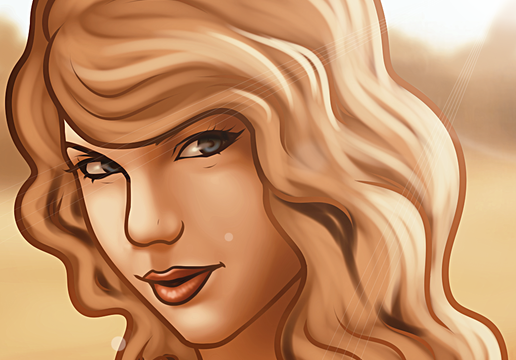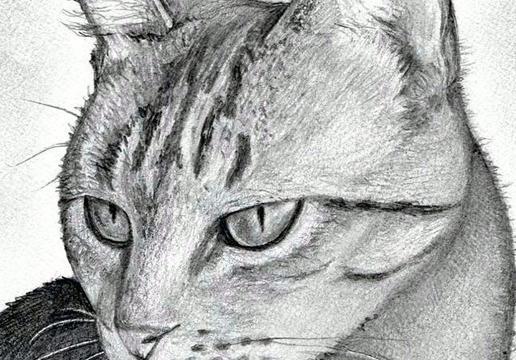How to Draw Mel Gibson, Mel Gibson
1
Draw the oval lightly with a No.2 or HB pencil. Make sure you draw it as seen in the picture. As it is not even a perfect jellybean shape. Draw it slanted towards the left.
4
You can draw in the lines a. for eyebrows, b. for eyes, c. for nose, d. for mouth placements. Also added e. for the shoulders.
6
Watch closely the side of Mel's and how it relates to the guidelines. As you draw, you will have more accuracy. Also sketch his forehead wrinkles, mouth, and jawline. When you sketch in his hairline, make sure you use small strokes to give it realism
7
If you haven't already, you can erase your guidelines. Also add those waved curly lines Mel's hair. Try staying close to the lines that represent the direction of his hair. This will help as you shade it in. Complete his neck and shoulder area.
8
I made this line drawing especially for you if you don't want to do the pencil shading and blending part. Otherwise, let us continue to the pencil drawing part.
9
Here is the outline done with a 0.7mm mechanical pencil. Look closely and see if your lines look something like this. You can erase if certain areas like the eyes or nose don't line up. TIP: For a more realistic picture you can lighten his upper chee
10
Lately, I've been doing a lot of portraits involving long, short, or curly hair. I feel a need to point out some tips in drawing hair. It's not all that hard. Seriously. It's the technique. I have done a hair tutorial, but for your help I'm incorpora
11
GO WITH THE FLOW: Basically, you're following the direction of object's shape, that is the hair. The hair will curl around, flow from, and slick to the head. The head is like a curved ball, so the hair extends from that ball by the arrowed directions
12
Best thing you can do when drawing hair is to establish the general shape then work in the main strands of hair by holding your pencil at a 45 degree angle for stroking and coverage. Then, as in the third picture, you can work in more details. But he
13
Here is a quick tip on different types of hair. In the picture follow the arrows. They represent the direction of the strokes. You can practice this now or later. Straight, a curl, cornrows, or a single braid is just a few ways different ethnic group
14
The picture that goes with this step shows two different ways to hold your pencil to acquire certain effects. OVERHAND: Holding a sharpened pencil in normal writing form with fingers in the middle or near the lead gives you great control and thin/det
15
PENCIL STROKES & TONE, SHADING, TEXTURE -- For your convenience, I have inserted this step with different pencils, strokes to use. And you can study the shapes that make up this drawing universe, along with tone, shading, and texture.
16
The picture here is a great exercise for value shading. I've got a little secret tip for you to make things easier. You can download this to your desktop. First click on the picture to have access to full size. By right clicking on your mouse, you ca
17
After printing out a number of the above template, practice shading in the values like this picture. You become familiar with this shading technique that gives you more control and confidence.
18
Since my picture was small with numerous details, I defined my lined boundaries first with a .07mm mechanical pencil for Mel's eyes and extra small areas. I also used my trusty 9B graphite pencil for larger areas and his hair.
19
This is the first sketch with the pastel application. Now if you were drawing in pencil, you would sketch in small circles or lines to shade the areas. It would take hours upon hours to cover all that area with a pencil. I chose to shade with pastels
20
I added some more dark gray to his eyebrows, hair, and jaw area. During this stage I used anything I could get my hands on. I mean, the picture I was drawing was too small to cover haphazardly with pastel. I my 9B, .07mm, pastels and worked with my
21
Hot dog! The blending stump had the quality of a pencil... I could shade, shade, shade until it looks like the photograph. And his hair is ridiculous! I took some opaque watercolor and a sable paint brush and stroked in some lighter strands of hair t
22
Without highlights, your picture would have a flat appearance. Click on this picture to learn how to make your own picture POP out!
Comments 0
Details
January 29, 2012
Description: Mel Gibson, (born 3 January 1956) is an American actor, film director, producer and screenwriter. I didn't know Mel was born in Peekskill, New York, and then moved with his parents to Sydney, Australia when he was 12 years old. I thought he was born in Australia. To continue, he later studied acting at the Australian National Institute of Dramatic Art. After appearing in the Mad Max and Lethal Weapon series, Gibson went on to direct and star in the Academy Award-winning Braveheart, which I have done the tutorial picture from. In 2004, he directed and produced The Passion of the Christ, a controversial yet successful film portraying the last hours in the life of Jesus (loved that movie. Not too long ago, Mel went on to make terrible accusations for which he apologized and denied that it wasn't he true opinions. This may have damaged his career for a bit, but I still love his movies. I hope you enjoy this tutorial. And please continue to comment, fav, and vote. Thank you everyone for your support! Love 'n hugs!














































